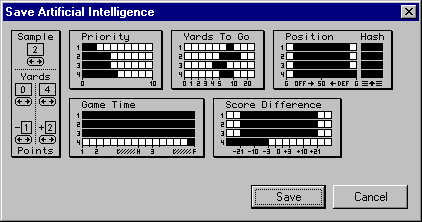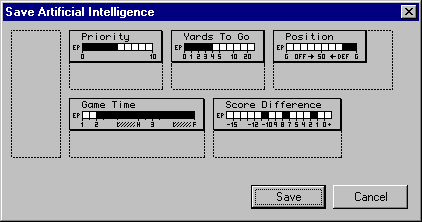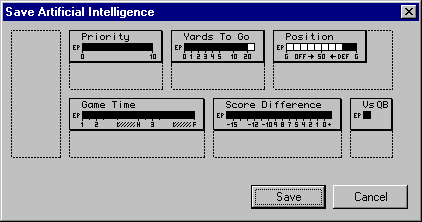
The computer has no way of inherently knowing which are the best plays in a playbook, or which plays are best suited for certain game situations. As play-designer and head coach of your team, only you know best. With this in mind, PlayMaker Football™ provides a way of letting you convey this knowledge to the computer (you can think of the computer as your assistant head coach) via the powerful Artificial Intelligence window.
The Artificial Intelligence window consists of a series of parameters that let you easily describe when to call a particular play, the quality of the play, expected results of the play and how to adjust the play calling strategy if the play is unsuccessful or very successful against an opposing team.
When you are personally coaching your team, you can call any play at any time. But if the computer coaches your team, it relies exclusively on the information you provide in the Artificial Intelligence window to make its play-calling decisions. In this way the computer can mimic your football coaching style!
It is not necessary to describe the computer coaching intelligence for your playbook, however if you ever want to have the computer act as coach for your playbook (either you play against your own team, or your team plays against someone else while you're not present, or you run a computer vs. computer tournament) you will need to describe the Artificial Intelligence for each play in your playbook.

The sections which are labeled Priority, Yards To Go, Position, Game Time and Score Difference are used to describe conditions when a particular play should be called. The numbers 1, 2, 3 and 4 going down the sides of each section represent downs. The boxes to the right of each down have different meanings depending on the category, and are described in detail below. When a box is filled in with black, it is considered "on". If it is white, it is considered "off". To turn a box on or off, simply point to it and click the mouse.
PRIORITY: This setting influences how frequently a particular play is called. During a game, the computer scans the entire playbook looking for all plays which have Artificial Intelligence window diagrams that match the current game situation. Once these plays are identified the Priority setting for each play is considered together with a small random factor, and the final play calling decision is made.

Example: To have a play called 50% of the time on 2nd down, click on the 5th box in the second row. The higher the Priority value, the more likely it is that the computer will call the play, providing the Artificial Intelligence window conditions match the current game situation.
When the computer is coaching your team, the Priority value can change during the game. See the Adapting to Opponents section below for more details.
YARDS TO GO: This setting describes the down and yards to go situation that is required for the current play to be called during a game. When the computer needs to call a play, it scans the entire playbook looking for plays with Artificial Intelligence window conditions that match the current game situation. Yards To Go is one of the conditions that must match.
The Yards To Go area has four horizontal rows of boxes. Each row represents one of the four downs. Each box represents a certain number of yards to go, which are indicated at the bottom.

The computer coach would interpret the example above in the following way: Call the play if it's 1st down and 10 yards to go or fewer; 2nd down and it's 7.5 yards to go or fewer; 3rd down and there are between 3 and 7.5 yards to go. Don't call this play on any 4th down situation.
FIELD POSITION: This setting indicates where on the field the current play should be called during a game. When the computer needs to call a play, it scans the entire playbook looking for plays with Artificial Intelligence window conditions that match the current game situation. Field Position is one of the conditions that must match.
The Field Position area has four horizontal rows of boxes. Each row represents one of the four downs. Each box represents a 10 yard segment of the football field.
The OFF and DEF indicators at the bottom of the area indicate the Offensive or Defensive orientation on the field. If you are describing the Field Position for an offensive play, assume your team is moving towards the goal on the right. If you are describing the Field Position for a defensive play, assume your team is defending the goal on the right.

The computer coach would interpret the example above in the following way, assuming it was on offense: On 1st and 2nd down, call the play anywhere on the field. On 3rd down, call the play anywhere on the field, except within your own 10 yard line. Don't call this play on 4th down.
HASH MARK DESIGNATION: The Artificial Intelligence window lets you designate valid ball placement positions for a particular play to be run.

For each down, you can specify the left hash mark, center of the field and/or the right hash mark to indicate where on the field you want your play run. At least one of the hash mark boxes needs to be checked on each down the computer is to consider calling the play.
Example: If you check the left hash mark and center boxes for first down, the computer coach will only consider calling the play if the ball is placed on either the left hash mark or center of the field on first downs.
GAME TIME: This setting indicates when during the game the current play should be called. When the computer needs to call a play, it scans the entire playbook looking for plays with Artificial Intelligence window conditions that match the current game situation. Game Time is one of the conditions that must match.
The Game Time area has four horizontal rows of boxes. The time increments are as follows: In the 1st and 3rd quarters, the first box represents the first 10 minutes of the quarter and the second box represents the last 5 minutes of the quarter. In the 2nd and 4th quarters, the first two boxes represent 5 minutes each, the third box represents 3 minutes, the next two boxes represent 1 minute each and the last box represents the last play.
Please note that only two boxes are dedicated to the first and third quarters, while the 2nd and 4th quarters contain six boxes each.
The "last play" box is used to designate the last play to be called before time runs out. If your team is ahead, this should probably be a conservative running play. If you are behind, it's time to unleash a long bomb or kick that last second field goal.

The computer coach would interpret the example above in the following way: On 1st, 2nd and 3rd down call this play any time during the 1st and 3rd quarters, but in the 2nd and 4th quarters call this play during the first 13 minutes, but not the last not or for the last play. Don't ever call this play on 4th down.
SCORE DIFFERENCE: This setting indicates the score situation for calling the current play. When the computer needs to call a play, it scans the entire playbook looking for plays with Artificial Intelligence window conditions that match the current game situation. Score Difference is one of the conditions that must match.
The Score Difference area has four horizontal rows of boxes. Each row represents one of the four downs. Each box represents a value which is the difference in score between your team and the opponent. The middle box, labeled 0, represents a tie score. Positive scores are indicated to the right and negative scores to the left in the following increments: 0, 3, 7, 10, 14, 21, 28, 35 or greater.

The computer coach would interpret the example above in the following way: On 1st down, call the play if we are down by no more than 7 points or are ahead. On 2nd down, call the play if we are down by no more than 10 points or are ahead. On 3rd down, call the play only if we are ahead by more than 10 points. Don't call this play on 4th down.
A good football coach monitors his team's performance during a game, making subtle adjustments, calling successful plays more often and eliminating unsuccessful plays from the game plan.
No matter how well one of your plays works against your own defenses on the Practice Field, you can never be sure how it will stack up against another team during a game. The play you expected to use as your "bread and butter" yardage gainer may be totally ineffective against a particular team's defense, or maybe your unbeatable blitz gets burned every time by a clever screen pass the other team likes to throw often.
If you were personally coaching your team when these situations occurred, you would start calling different plays until you, hopefully, found one that worked, and you would definitely not be blitzing as much. The key to winning football is identifying your opponent's weaknesses and exploiting them, and at the same time maximizing your own team's strengths.
The area at the left of the Artificial Intelligence window allows you to convey just such characteristics to the computer coach.

This part of the Artificial Intelligence window tells the computer how often it should evaluate the performance of a play. Once the play is evaluated, the computer will increase the Priority for that play (during the game!) if it has been successful, or it will decrease the Priority if the play has not been effective. In this way, the computer adapts to different opponents, and doesn't get stuck in an endless play-calling rut.
Each of the numbers in this area can be adjusted by clicking the left and right arrows just below the number you want to change.
SAMPLE: The number entered here tells the computer how often to evaluate a particular play. For every play it calls, the computer maintains a running average of how many yards the play gained or lost. In the case of defensive plays, the computer keeps a running average of how the opposing offense performed against each defensive play.
When the Sample number for a play is encountered, the computer evaluates the average yards gained or lost and makes the necessary adjustments.

The computer would interpret the above example as follows: every two times this play is called, evaluate its performance by comparing the average yards it has gained or lost to the Yards numbers (see below) and if necessary, adjust the Priority (see below).
A Sample rate of 1 means the computer evaluates the play each time it calls it. A Sample rate of 0 means the computer never evaluates the play.
YARDS: The numbers entered here define successful and unsuccessful performance for a play. When the computer evaluates a play, it compares the average yards gained or lost to the numbers in the Yards boxes.

The computer would interpret the above example as follows, assuming it was on offense: If the play being evaluated has averaged a loss of 2 or more yards then adjust the Priority (see below). If the play has averaged 5 or more yards then adjust the Priority (see below). If the play has averaged between -1 and 4 yards, don't make any adjustments to the Priority.
Interceptions And Artificial Intelligence: It is important to note that the offensive artificial intelligence treats an interception as a loss of 50 yards. This should be taken into account when programming your artificial intelligence and sample rates for passing plays.
It's important to note that the interpretation of the Yards numbers is slightly different for offensive and defensive plays. For offensive plays the computer is comparing the average yards gained or lost by the current play:
|
||||||
For defensive plays, the computer is comparing the average yards given up by the current play:
|
||||||
POINTS: The numbers entered here indicate how drastically the Priority for a play should be changed should the play match or exceed the Yards values (see above). In this way, the computer is able to increase the Priority for plays which are successful, and decrease the Priority for unsuccessful plays.

The computer would interpret the above example as follows: If the play being evaluated has averaged a number of yards that equals or exceeds the left Yards number, then reduce the Priority by 1 point. If the play has averaged a number of yards that equals or exceed the right Yards number, then increase the Priority by 2 points.
The Artificial Intelligence settings for extra points and two-point conversions differ slightly from regular plays. The main difference is the Score Difference area which allows for a finer distinction in selecting when to call a two-point conversion.

The computer would interpret the above example as follows: This play has a Priority of 5 and should be called when there are four or less Yards To Go; the Position setting takes into account that penalties may back the offense up and allows this play to be called anywhere from the 20 yard line to the goal line; Game Time will not allow this play to be called in the first quarter, but it can be called in the second, third or fourth; and finally, the Score Difference tells the computer to call this play only when down by 2, down by 8, or down by 11.
On defense the Score Difference is aided by a check box Vs QB that tells the computer which plays to call when a quarterback is on the field and which plays to be called when the kicking team comes on. This allows the defense the option of trying to block the kick or making sure that they have some type of short goal line defense called when the quarterback comes on.

The computer would interpret the above example as follows: This play has a Priority of 10 and therefore will be called almost all the time; Yards To Go tells the computer to call this play when there are 20 or less yards to go; the Position setting takes into account that penalties may back the offense up and allows this play to be called anywhere from the 20 yard line to the goal line; Game Time calls for this play to be called at any time during the game; the Score Difference tells the computer to call this play not matter what the score is; and finally, and very importantly in the case of this play, the check box, Vs QB tells the computer to only call this play if the quarterback is on the field.
WHEN NOT TO CALL A PLAY: One of the easiest ways to describe situations when a play should be called is simply to think in terms of when the play should NOT be called, and make sure there are no boxes checked for those cases.
DUPLICATE PLAYS: In some cases you may need to have two copies of the same play (make sure you name them differently) each with slightly different AI if you need to describe several complex situations. The most common use of this technique is for two-minute drills, where you would make duplicate copies of your best plays but change the AI so it describes the situation of your team losing late in the game.
FOURTH DOWN SITUATIONS: Make sure your playbook contains some regular scrimmage plays for 4th down situations where you want to "go for it". Otherwise, your team will always try a punt or field goal on 4th down. This is especially important for end game situations where you need a deep pass to try and score a desperation touchdown to win.
STREAMLINING PLAYBOOKS: If your playbook contains too many plays, you may notice that your computer strategy doesn't have an opportunity to play itself out. Avoid overcrowding your playbook with unnecessary plays. If you work on your playbook a lot, make a habit of periodically scanning through it and removing obsolete plays. The best playbooks contain only the best plays, and enough plays to cover all game situations.
COACHING CHANGES: If your team is consistently losing when it is controlled by the computer, try making subtle modifications to the Artificial Intelligence before you make wholesale changes to your plays. Your playbook probably contains many excellent plays, but the computer is just not calling them in the appropriate situations or with the proper frequency.
|
|
||

|

|

|
| Previous | Next | |